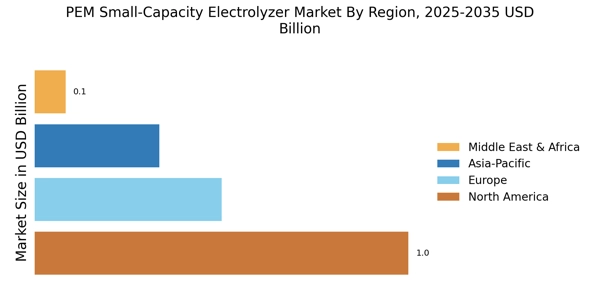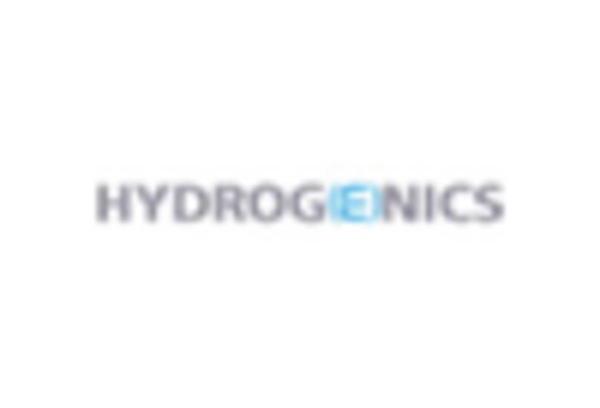Supportive Regulatory Frameworks
The PEM Small-Capacity Electrolyzer Market is benefiting from supportive regulatory frameworks that promote the adoption of hydrogen technologies. Governments across various regions are implementing policies and incentives to encourage the development and deployment of clean hydrogen solutions. For example, initiatives such as tax credits, grants, and subsidies for renewable energy projects are fostering a conducive environment for the growth of the electrolyzer market. The European Union has set ambitious targets for hydrogen production, aiming for 10 million tons of renewable hydrogen by 2030, which is likely to stimulate demand for PEM small-capacity electrolyzers. This regulatory support not only enhances market confidence but also attracts investments in research and development, further propelling the industry's growth.
Advancements in Electrolyzer Technology
Technological innovations are significantly influencing the PEM Small-Capacity Electrolyzer Market. Recent advancements in materials and design have enhanced the efficiency and durability of electrolyzers, making them more attractive for various applications. For instance, the development of advanced catalysts and membrane technologies has improved the overall performance of PEM electrolyzers, leading to lower operational costs. The market is expected to witness a compound annual growth rate of around 15% over the next five years, driven by these technological improvements. Furthermore, the integration of smart technologies and automation in electrolyzer systems is likely to enhance operational efficiency and reduce maintenance requirements. As a result, the PEM small-capacity electrolyzers are becoming increasingly viable for both commercial and residential applications.
Integration with Renewable Energy Sources
The PEM Small-Capacity Electrolyzer Market is increasingly integrating with renewable energy sources, which is a crucial driver for its growth. As the world transitions to renewable energy, the need for efficient hydrogen production methods becomes paramount. PEM electrolyzers can effectively utilize excess energy generated from solar and wind sources, converting it into hydrogen for storage and later use. This synergy not only enhances the viability of renewable energy projects but also contributes to grid stability. The market for renewable hydrogen is projected to grow significantly, with estimates suggesting a potential market size of over 300 billion USD by 2035. This integration is likely to create new opportunities for the PEM small-capacity electrolyzer market, as stakeholders seek to optimize energy production and consumption.
Increasing Demand for Clean Energy Solutions
The PEM Small-Capacity Electrolyzer Market is experiencing a surge in demand for clean energy solutions, driven by the global shift towards sustainable energy sources. As nations strive to meet their carbon reduction targets, the need for hydrogen production through electrolysis is becoming increasingly critical. The market for hydrogen is projected to reach approximately 200 billion USD by 2030, indicating a robust growth trajectory. This demand is further fueled by the rising awareness of environmental issues and the need for energy security. Consequently, the PEM small-capacity electrolyzers, which offer efficient and scalable hydrogen production, are positioned to play a pivotal role in this transition. The industry's growth is likely to be supported by favorable government policies and incentives aimed at promoting clean energy technologies.
Growing Interest in Decentralized Energy Systems
The PEM Small-Capacity Electrolyzer Market is witnessing a growing interest in decentralized energy systems, which are becoming increasingly relevant in the context of energy independence and resilience. As communities and businesses seek to reduce their reliance on centralized energy sources, small-capacity electrolyzers offer a practical solution for localized hydrogen production. This trend is particularly evident in remote areas where access to traditional energy infrastructure is limited. The ability to produce hydrogen on-site can enhance energy security and reduce transportation costs. Market analysts suggest that the demand for decentralized energy solutions could lead to a significant increase in the adoption of PEM small-capacity electrolyzers, potentially doubling their market share within the next decade.


















Leave a Comment